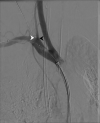ProGlide entrapment of the occlusive balloon during repair of an iatrogenic subclavian artery injury
- PMID: 37780972
- PMCID: PMC10513006
- DOI: 10.1259/bjrcr.20230015
ProGlide entrapment of the occlusive balloon during repair of an iatrogenic subclavian artery injury
Abstract
The insertion of any central venous catheter (CVC) is associated with a risk of damage to neurovascular structures, pneumothorax, cardiac arrhythmias, and infection1. Unintentional arterial puncture remains rare, occurring in 6.3-9.4% of attempted internal jugular vein (IJV) catheterisation and 3.1-4.9% of attempted subclavian vein catheterisation2. We present a previously undocumented complication encountered while utilising the Perclose ProGlide device in the case of a 59-year-old male who underwent right subclavian artery closure following the accidental insertion of a 14Fr Vascath into the right subclavian artery. This was performed using two ProGlide devices and one Angio-Seal device. Following deployment of the ProGlide devices, an uninflated balloon passed into the subclavian artery as a precaution, but not used, was removed. One of the ProGlide devices became dislodged having been deployed into the balloon, threatening haemostasis.
© 2023 The Authors. Published by the British Institute of Radiology.
Figures



Similar articles
-
A randomized trial comparing compression, Perclose Proglide and Angio-Seal VIP for arterial closure following percutaneous coronary intervention: the CAP trial.Catheter Cardiovasc Interv. 2008 Jan 1;71(1):1-5. doi: 10.1002/ccd.21333. Catheter Cardiovasc Interv. 2008. PMID: 18098171 Clinical Trial.
-
Endovascular Repair Using Suture-Mediated Closure Devices and Balloon Tamponade following Inadvertent Subclavian Artery Catheterization with Large-Caliber Hemodialysis Catheter.Korean Circ J. 2016 Jul;46(4):584-7. doi: 10.4070/kcj.2016.46.4.584. Epub 2016 Jul 21. Korean Circ J. 2016. PMID: 27482271 Free PMC article.
-
Off-label use of Proglide percutaneous closure device in iatrogenic arterial catheterizations: Our experience.Vascular. 2020 Dec;28(6):756-759. doi: 10.1177/1708538120925603. Epub 2020 May 21. Vascular. 2020. PMID: 32437239
-
Perclose ProGlide embolization as a complication: case report and review of literature.Future Cardiol. 2021 Oct;17(7):1193-1197. doi: 10.2217/fca-2020-0154. Epub 2021 Jan 15. Future Cardiol. 2021. PMID: 33448229 Review.
-
Endovascular repair of inadvertent subclavian artery perforation during cannulation for dialysis access: case report and review of the literature.Eur J Emerg Med. 2009 Dec;16(6):323-6. doi: 10.1097/MEJ.0b013e32832a0851. Eur J Emerg Med. 2009. PMID: 19318956 Review.
References
Publication types
LinkOut - more resources
Full Text Sources

